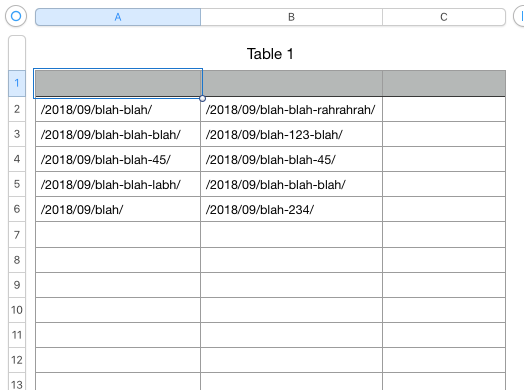I have a Numbers sheet that is thousands of rows long. As an example in the image, the sheet has two columns with URLs. What I need to do is find the rows that have the same URL in the two adjacent cells and then change the background color of that row so I can identify the rows and delete them; or write the word "dupe" to column C. In the example, row 4 has the same URL the two cells. How would I flag or mark rows like that in the entire sheet? With a calculation? Or an Applescript/Automator?
1 Answer
Here is an AppleScript method, which demonstrates three different types of action taken upon the rows with duplicate cell entries in columns "A" and "B" (equivalent to cells 1 and 2):
use N : application "Numbers" -------------------------------------------------------------------------------- # PROPERTY VALUES & GLOBAL VARIABLES property document : a reference to document 1 of N property sheet : a reference to active sheet of my document property table : a reference to table 1 of my sheet global them -------------------------------------------------------------------------------- # IMPLEMENTATION: on run if not (exists my table) then return false set them to a reference to (every row of my table ¬ where the value of cell 1 = the value of cell 2 ¬ and the value of cell 1 ≠ missing value) highlight() ---OR: -- comment() --OR: -- delete -- WARNING: permanent! end run -------------------------------------------------------------------------------- # HANDLERS: to highlight() set the background color of them to ¬ {65535, 65535 / 4, 65535 / 2} end highlight to delete delete them end delete to comment() set the value of cell 3 of them to "SNAP!" end comment ---------------------------------------------------------------------------❮END❯ I've defined three handlers, highlight(), comment(), and delete, each of which, if called, will perform a particular action upon the rows of interest. Currently, you can see in the script a few lines within the section labelled IMPLEMENTATION: that I've set it currently to perform the highlight() action, which will change the particular rows' background colour to a shade of pink I like.
Below that line are commands that I have commented out using --, so currently they remain inert. When uncommented, the comment() handler will enter the word "SNAP!" into the third column of each row of interest; and the delete command (note the lack of parentheses for this one) will simply delete the rows completely. I've marked this with a warning that implies permanent deletion, although in truth, you can recall the rows back into existence using the application's builtin Undo menu item, or ⌘Z (on a one-by-one basis!)
- 1Nice shade of pink! :) +1user3439894– user34398942018-11-12 21:34:05 +00:00Commented Nov 12, 2018 at 21:34
- Thanks, this works great and is a good example for working with Numbers.BlueDogRanch– BlueDogRanch2018-11-13 16:34:47 +00:00Commented Nov 13, 2018 at 16:34


IF(A2=B2,"DUPE","")as a new formula in C2... then with C2 selected press Command-C to copy the formula... then scroll down to the last row containing info and press the Shift key while clicking the last cell in column C to select the range and press Control-C to paste the formula. Now with column C having "DUPE" where appropriate, I'd then sort the sheet on column C and highlight the rows with "DUPE" in them and delete them. Then select column C and press delete to remove the formula.